What is a Medication Administration Record Sheet?
A Medication Administration Record Sheet, often referred to as a MAR, is a comprehensive chart used in healthcare settings to record all the medications prescribed and administered to a patient over a certain period. This document includes critical information such as the consumer’s name, medication details, dosage times, attending physician, and the specific month and year of the record. It also provides a system for noting any changes to the medication regimen, including refused, discontinued, or altered doses.
How is the "R = REFUSED D = DISCONTINUED H = HOME D = DAY PROGRAM C = CHANGED" notation used?
This notation system allows healthcare providers to quickly document the status of each medication dose. If a patient refuses a dose, "R" is marked; if the medication is discontinued, "D" is noted; a dose taken at home is marked as "H"; "D" can also stand for medications taken while in a day program, and "C" indicates any change in the medication regimen. This efficient method ensures clarity and accuracy in the patient’s medication administration record.
Why is it important to record medication at the time of administration?
Recording medication at the time of administration is crucial for maintaining an accurate and up-to-date account of a patient's medication management. This practice minimizes the risk of errors, such as double dosing or skipping a dose, thus ensuring the patient receives the proper care. Furthermore, it supports accountability and provides a clear audit trail that can be essential in evaluating the patient's response to treatment and making informed healthcare decisions.
What should you do if a patient refuses medication?
If a patient refuses medication, it is important to record the refusal in the MAR using the "R" notation and immediately notify the attending physician or a healthcare provider. Understanding and documenting the reason for refusal can be valuable for assessing whether adjustments to the treatment plan are necessary. It’s also essential to ensure that the patient is informed about the potential risks of skipping their medication.
How does the MAR handle changes in medication?
Changes in a patient's medication regimen are common and are handled meticulously in the MAR. When a medication is changed—whether in dosage, time, or even when discontinuing it—this alteration is noted with a "C" for changes or "D" for discontinued. Recording these changes diligently ensures that all healthcare providers involved in the patient's care are up-to-date with the most current treatment plan.
What is the significance of noting medications taken at home or in a day program?
The notations "H" for home and "D" for day program are significant because they acknowledge the different environments in which a patient may receive medication. This distinction is essential for coordinating care and ensuring continuity. It helps healthcare providers understand the full scope of the patient’s medication regimen, including doses administered outside of the primary healthcare setting, leading to a more comprehensive approach to treatment and monitoring.

